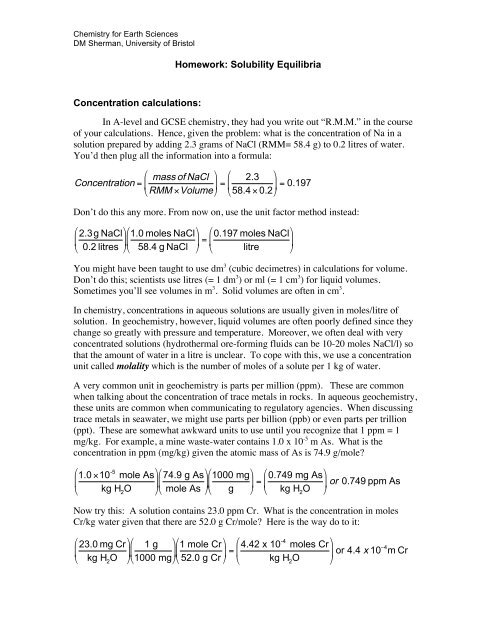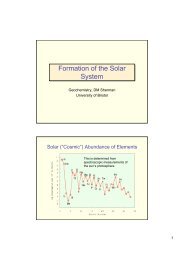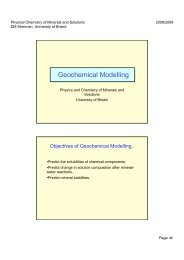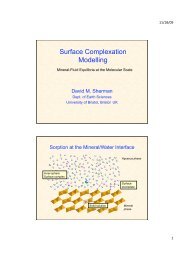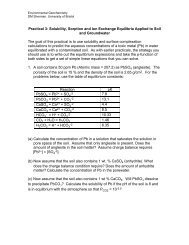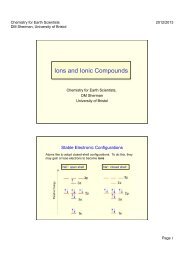Solubility problems - Aqueous and Environmental Geochemistry
Solubility problems - Aqueous and Environmental Geochemistry
Solubility problems - Aqueous and Environmental Geochemistry
You also want an ePaper? Increase the reach of your titles
YUMPU automatically turns print PDFs into web optimized ePapers that Google loves.
Chemistry for Earth Sciences<br />
DM Sherman, University of Bristol<br />
Homework: <strong>Solubility</strong> Equilibria<br />
Concentration calculations:<br />
In A-level <strong>and</strong> GCSE chemistry, they had you write out “R.M.M.” in the course<br />
of your calculations. Hence, given the problem: what is the concentration of Na in a<br />
solution prepared by adding 2.3 grams of NaCl (RMM= 58.4 g) to 0.2 litres of water.<br />
You’d then plug all the information into a formula:<br />
⎛ mass of NaCl ⎞ ⎛ 2.3 ⎞<br />
Concentration = ⎜<br />
⎟ = ⎜ ⎟ = 0.197<br />
⎝ RMM ×Volume⎠<br />
⎝ 58.4 × 0.2⎠<br />
Don’t do this any more. From now on, use the unit factor method instead:<br />
€<br />
€<br />
⎛<br />
⎜<br />
⎝<br />
2.3g NaCl<br />
0.2 litres<br />
⎞ ⎛ 1.0 moles NaCl⎞<br />
⎛<br />
⎟ ⎜<br />
⎟ = ⎜<br />
⎠ ⎝ 58.4 g NaCl ⎠ ⎝<br />
0.197 moles NaCl<br />
litre<br />
You might have been taught to use dm 3 (cubic decimetres) in calculations for volume.<br />
Don’t do this; scientists use litres (= 1 dm 3 ) or ml (= 1 cm 3 ) for liquid volumes.<br />
Sometimes you’ll see volumes in m 3 . Solid volumes are often in cm 3 .<br />
⎞<br />
⎟<br />
⎠<br />
In chemistry, concentrations in aqueous solutions are usually given in moles/litre of<br />
solution. In geochemistry, however, liquid volumes are often poorly defined since they<br />
change so greatly with pressure <strong>and</strong> temperature. Moreover, we often deal with very<br />
concentrated solutions (hydrothermal ore-forming fluids can be 10-20 moles NaCl/l) so<br />
that the amount of water in a litre is unclear. To cope with this, we use a concentration<br />
unit called molality which is the number of moles of a solute per 1 kg of water.<br />
A very common unit in geochemistry is parts per million (ppm). These are common<br />
when talking about the concentration of trace metals in rocks. In aqueous geochemistry,<br />
these units are common when communicating to regulatory agencies. When discussing<br />
trace metals in seawater, we might use parts per billion (ppb) or even parts per trillion<br />
(ppt). These are somewhat awkward units to use until you recognize that 1 ppm = 1<br />
mg/kg. For example, a mine waste-water contains 1.0 x 10 -5 m As. What is the<br />
concentration in ppm (mg/kg) given the atomic mass of As is 74.9 g/mole?<br />
⎛ 1.0 ×10 -5 mole As⎞<br />
⎛ 74.9 g As⎞<br />
⎛ 1000 mg⎞<br />
⎛ 0.749 mg As⎞<br />
⎜<br />
⎟ ⎜ ⎟ ⎜ ⎟ = ⎜<br />
⎟ or 0.749 ppm As<br />
⎝ kg H 2<br />
O ⎠ ⎝ mole As ⎠ ⎝ g ⎠ ⎝ kg H 2<br />
O ⎠<br />
€<br />
Now try this: A solution contains 23.0 ppm Cr. What is the concentration in moles<br />
Cr/kg water given that there are 52.0 g Cr/mole? Here is the way do to it:<br />
⎛<br />
⎜<br />
⎝<br />
23.0 mg Cr<br />
kg H 2<br />
O<br />
⎞ ⎛ 1 g ⎞ ⎛ 1 mole Cr⎞<br />
⎛<br />
⎟ ⎜ ⎟ ⎜ ⎟ = 4.42 x 10-4 moles Cr⎞<br />
⎜<br />
⎟ or 4.4 x 10 −4 m Cr<br />
⎠ ⎝ 1000 mg⎠<br />
⎝ 52.0 g Cr ⎠ ⎝ kg H 2<br />
O ⎠<br />
€
Chemistry for Earth Sciences<br />
DM Sherman, University of Bristol<br />
This explicit writing-out of the units might seem to be a needless tedium to you; however,<br />
it will save you much grief down the road <strong>and</strong> will enable you to solve <strong>problems</strong> that you<br />
couldn’t do otherwise. Cr <strong>and</strong> As are carcinogenic. Getting your calculations wrong<br />
may l<strong>and</strong> you in court!<br />
Problems:<br />
1. Calculate the molal concentration of Ca when 0.05 g of CaCl 2 is dissolved in 350 ml of<br />
water. The formula mass of CaCl 2 is 111.4 g/mole.<br />
2. The concentration of Zn in acid-mine waste is 50 ppm (= 50 mg/kg). What is the<br />
molar concentration of Zn given that the atomic mass of Zn is 65.4 g/mole.<br />
3. The equilibrium constant for the reaction<br />
BaSO 4 = Ba +2 + SO 4<br />
-2<br />
is 1.07 x 10 -10 . What is the concentration of Ba +2 in a solution in equilibrium with BaSO 4 ?<br />
4. Solve problem 3 again but when the solution is also saturated with gypsum<br />
CaSO 4 .2H 2 O. The equilibrium constant for the reaction<br />
is 3.31 x 10 -5<br />
CaSO 4 = Ca +2 + SO 4<br />
-2


